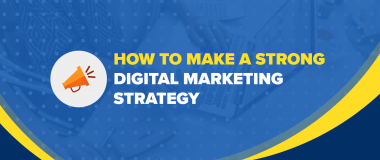Digital storytelling encompases all innovative ways in which marketers can share content and raise the appeal of their brand. Storytelling is a tried and true method that helps individuals, organizations, and institutions communicate, educate and connect. By creating stories on Instagram, short YouTube videos, insightful Tweets, or Facebook announcements, businesses have plenty of opportunities to reach their audiences and engage them in new inspiring ways.
When telling a story, marketers have to be considerate of the channel they’re using and be familiar with its tools and best practices. Different platforms call for different forms of content and in order to benefit from all the features, you need to be smart and use them wisely.
To produce narratives that stick, great storytellers think and then rethink, work and then rework their pieces. You have to attach emotions to your message. Facts, figures and all the other purely rational things considered to be important in the business world, should only support your message, not be the essence of it. The goal is to blend expectations and reality and invite your viewers to resonate with your brand.
In this article, we share with you why digital storytelling is so important for establishing a strong connection with your audience and what are its key elements.
Why Do We Need Digital Storytelling?
Before we go into the fundamentals, let’s talk a bit about what makes digital storytelling important.
Digital storytelling is essential for uniting people and fostering strong meaningful connections. Тhe digital world offers many advantages to marketers to share the right narrative and communicate their message. Instead of just talking to their prospects, stories allow brands to start conversations and form connections that go beyond their products/services.
To share a great story, it’s important that you show humanity and create an emotional bond with your customers. Your audience’s perception of your brand isn’t made up solely of the interactions they have with it. In fact, it’s created by the value they receive from their whole experience with your business – from the moment they discover it until they make a purchase.
Telling your story digitally can be a bit tricky. You have to think about which tone to use, how to share your vision authentically, why it relates to your brand mission, which content you should present it in, and how technology can help you spread your message effectively.
To make your job easier, below we have outlined the 8 key elements of digital storytelling, as well as some dos and don’ts to keep in mind.
1. A Captivating Massage
Digital storytelling enables you to share your brand’s message and values in a way that helps your customers relate to them and support your business. So, before you start drafting you need to settle on what you ultimately want to communicate and then discover the best way to do it.
A clear and compelling message is the foundation of any story, which is why it should be established upfront. Try to think about the main idea of your story, and how you can define it. Be well aware of who your audience is and how you can resonate with them. Then summarize your findings in a single sentence.
Here’s an example from Whole Foods Market:
“We’re the place to discover new flavors, new favorites and new ideas, whatever those might be.” – Whole Foods Market
2. The Audience as the Hero
Every story has a cause-effect plot, in which a protagonist and an antagonist interact with each other to overcome obstacles and reach their desired goal. While your brand can be a central figure in your narrative, ultimately the focus should remain on your audience.
According to Forbes, the most powerful brand stories have customers as the heroes, so they can more easily identify with the product. One way to help them achieve this is to show them a reality in which they can be a better version of themselves. This way they will be more motivated to be loyal to your brand and advocate for it.
When you tell a story in the digital world you need to build lasting and durable relationships with your prospects. An amazing campaign should have multiple touch points for interactions and the experiences at each touch point should relate to the narrative you’re presenting.
If you do this successfully you’ll be able to give your clients a completely different entry to your brand. Thanks to this they’ll be more engaged and willing to believe in your message.
3. Humanity
Digital storytelling gives you a platform where you can emphasize the human side of your business. People connect better with people, so why not share a behind the scenes look of who is behind all the hard work.
Great storytelling portrays real challenges, emphasizing on the core reason for the conflict and presenting hope. So, why not show what is the culture inside the company, who your team is, what they do on a daily basis, how they approach challenges, and what they learn from them.
Remember to keep your story simple and straightforward. One way to do this is by using a few interesting and carefully placed details to make your audience part of your tale. Just remember to stay humble and show real emotions and expressions.
4. Truthfulness and Authenticity
A successful story is nothing without authenticity and that goes hand-in-hand with being true to yourself and your audience. A good narrative blends emotions with information and helps give your audience an experience that they will remember.
Showcasing such a level of authenticity presents a challenge to many storytellers. If you want to touch the hearts of your customers you need to be able to open yours to them. In today’s digital world people are busier than ever and they don’t have a lot of time to go through a long message. Therefore, it’s extremely important that you make them curious and want to know what it is that you have to say.
Staying true to your audience means making a promise to them and delivering on it. Take the time to really understand the needs and wants of your users, as well as what they care about and would like to hear. Once you have that sorted, craft a story that takes your viewers along on an emotional, but satisfying journey. Try to keep the curiosity alive, offer suspense, and let it be known that their time will be worthwhile.
5. Following the Context
The context of your narrative is an essential part of your story. Storytelling is both a strategic and a tactical tool that helps businesses continuously engage with their audience. Setting the right context and following it is essential to getting your message across clearly and seamlessly.
A great approach is to relate so you can educate. Because they help transmit knowledge and meaning, stories are a great method for learning. What is more, people learn better from observing, experiencing things firsthand, and sharing those experiences.
As a brand you should always be looking for ways to learn more about your consumers and the problems that they face every day. Through storytelling you can better understand your marketplace and how the changes in it can affect your customers, brand, and company.
To adapt to the context successfully you can ask questions like:
- Why should our customers give us their time?
- Why do they need to hear our story?
- How is it different compared to any others out there?
The answers to these will help you add another dimension to your creative approach to marketing and help you present a different view of your brand.
6. Related to the Brand’s Mission
The stories you tell should include your brand’s value proposition and be worthy of your audience’s time and attention. They should capture and present what your business believes in while inviting others to adopt them as their own.
Whatever cause you’re trying to relate to in your storytelling should be important to both your audience and to your brand. If your goal is to bring great new services that can improve your customer’s lives, you need to make sure that this message does not get lost in translation. So, if you want to gain the support of your listeners you should present your mission in a way that evokes powerful emotions.
7. Embracing Technology
Digital storytelling enables businesses to have better control over their narrative. The various social media platforms out there like Instagram, Pinterest, LinkedIn, and YouTube provide an amazing opportunity for brands to share their values, purpose, personality, and humanity through compelling formats – images, videos, snippets, vision boards, etc.
You should bear in mind that each platform has its own specifications. Whenever you switch between them or decide to start using a new one, it’s important to build your entire storytelling experience around it.
At the end of the day, the most important goal is to resonate with your customers in a meaningful way, so you can build a stronger and deeper relationship with them.
How to Tell a Great Story Digitally?
Whichever way you decide to use digital storytelling you should remember that regardless of the medium and format there are some fundamental principles. This is an approach that is an art form that takes practice to perfect, but once you do, you can turn prospects into advocates, and build better and lasting relationships with them. Make sure you know your basics, and you’ll be able to take your audience on an amazing journey that will not only touch their hearts but stimulate their minds as well.
Conclusion
Storytelling enables any brand to engage, motivate, inspire, and innovate. By presenting ideas in an engaging way you can tap into your customer’s emotions and create stronger bonds with them.
In the digital world, storytelling can be challenging at times. Although, at the core, the principles of great stories still remain the same. The important thing is to better understand your prospects as well as the platforms you will find them on, have a clear and strong message and present it in a way that can help you build better connections.






